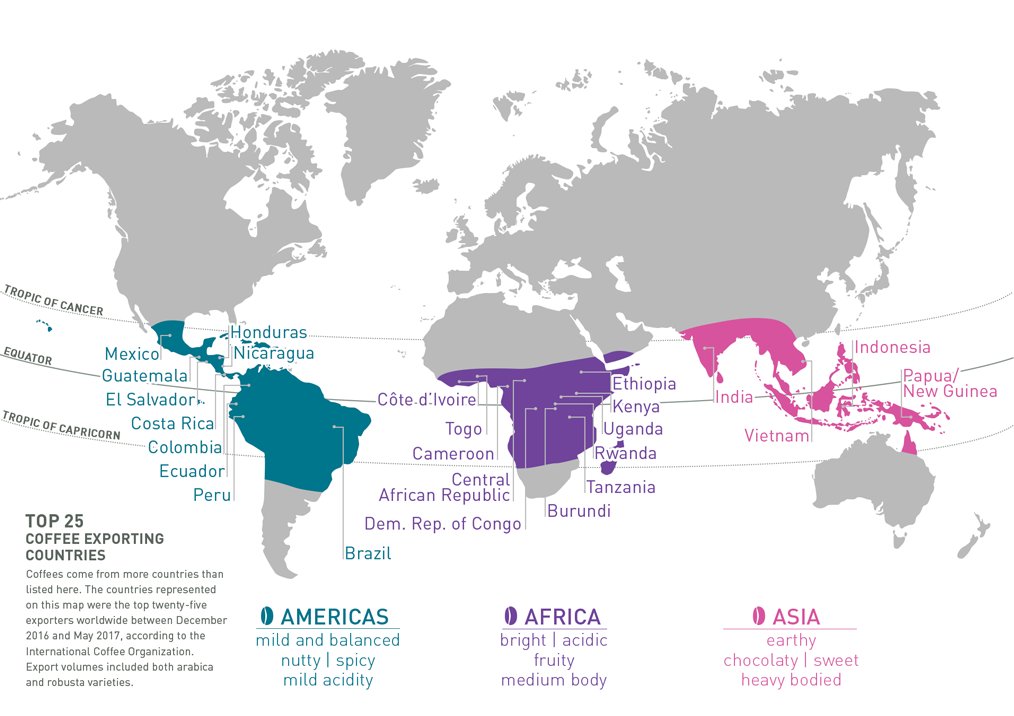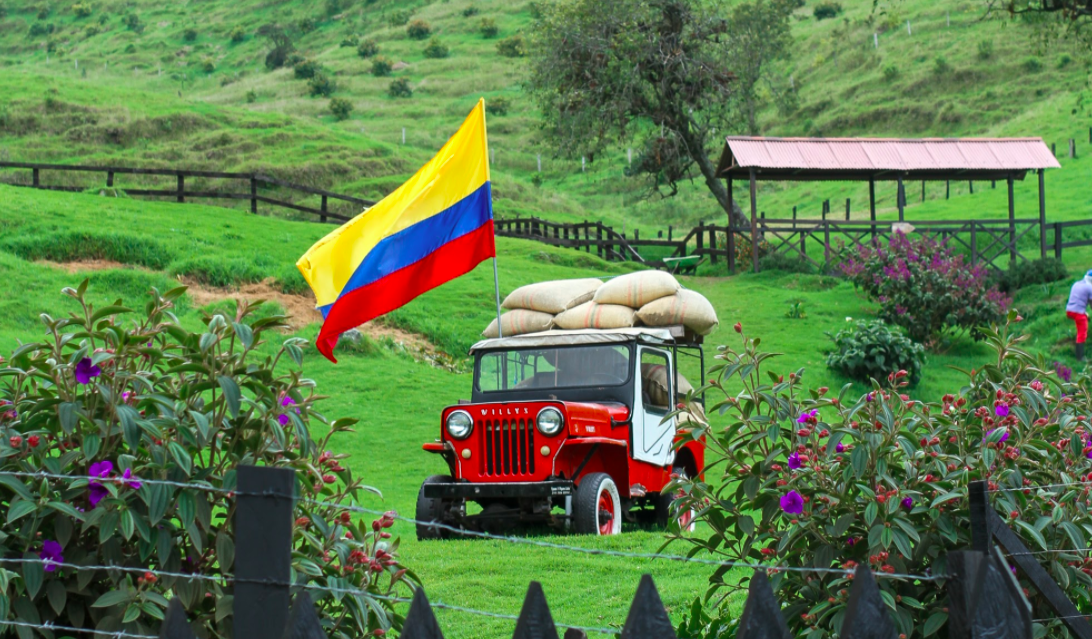1. Why is Colombian coffee famous?
Whether you are a coffee expert or simply a fan who enjoys a little healthy debate, Colombia’s name has likely come up when discussing the world’s best coffee producing countries. If you consider yourself a coffee drinker, there is a good chance that you have enjoyed a cup of Colombian coffee at some point. Colombia is the third largest global producer by volume, behind only Brazil and Vietnam. While most people may be aware of its popularity, not everyone knows exactly why Colombian coffee has such a strong reputation. So being Colombian, I feel I have a responsibility to present all the wonderful reasons why.
Colombian coffee is world famous for its balanced flavor and rich aroma. The coffee-growing conditions are ideal thanks to Colombia’s geographical location, tropical climate, volcanic soil, and high elevations. In addition, Colombian coffee is 100% Arabica (superior to the cheaper Robusta species), the coffee cherries are hand-picked during harvest (no machines), there is a large diversity of flavors found throughout Colombia’s numerous coffee regions, and there is a resounding national pride when it comes to coffee.
The secrets to Colombia’s success in producing some of the world’s finest coffees are many.
2. Geographical location and ideal conditions
-GEOGRAPHY-
Colombia is conveniently located in the Coffee “Bean Belt,” which wraps around the Equator and includes other coffee producing countries such as Brazil, Ethiopia and Indonesia. Being in the equatorial zone, Colombia receives constant solar radiation throughout the year.

The weather found in the tropics is essential for the development of coffee plants in their different stages. Its daily, seasonal, and annual variations determine the efficiency in the development of the crop.
-PERFECT TEMPERATURES-
Colombia offers regions with perfect weather conditions for coffee plants: temperatures between 19o-21oC (66o-70oF) with adequate water supply, no long periods with a lack or excess of water, and volcanic soil of excellent physical condition and good drainage.
There are no variations in temperature throughout the year thanks to Colombia’s position in the tropics. Evaporation is not very high given the climate, which prevents the soil from being too dry and wilting the coffee plant. There are also no frosts in these areas.
-ELEVATION-
Coffee grows best in volcanic soil between the elevations of 4,000 and 6,000 feet above sea level (1,200 and 1,800 MASL). Colombian coffee regions are located along the slopes of mountain chains that span across the country from South to North, and whose altitudes range 3,280 to 5,560 feet (1,000 to 1,700 MASL). While coffee only grows in tropical climates, the Colombian mountains offer cooler temperatures which extend the maturity time of the coffee fruit. This slowed process produces a denser bean and allows more time for the coffee to develop the complex sugars that ensure a balanced body and optimal acidity.
-VOLCANIC SOIL-
The soil found in the Colombian coffee regions is loaded with organic matter and minerals. This is due to the fact that it mostly comes from volcanic ash. The natural minerals provide excellent growing conditions and significantly reduce the need for fertilizers. The land is extremely fertile, naturally, as can be noted in the thick vegetation blanketing the mountains throughout the coffee regions.
Colombia has a total of 27 volcanoes, many of which are popular attractions for global travelers, including Nevado del Ruíz, Nevado del Huila, Nevado de Santa Isabel, and Nevado del Tolima.
-BIODIVERSITY, RAINFALL AND WATER SUPPLY-
Colombia is well-known as the #2 most biodiverse country in the world, and ranks third among the countries with the most water on earth.
The Colombian coffee zones generally receive two periods of heavy rainfall per year, which determine the coffee harvest seasons. Rain in these locations is highly influenced by the topographic conditions and by the movement of the valley-mountain winds.
Colombia essentially grows coffee all year round depending upon regionality, but the main harvest is primarily from October to March, with a mitaca fly crop from April until June.
3. Colombia produces 100% Arabica coffee
Colombia is one of the few countries that only grows Arabica beans. Known for its pronounced aroma, acidity, medium-high body, and cleanness, Colombian Arabica is often described as well-balanced or mild.
The world’s most important species of coffee are Arabica and Robusta. Arabica is widely recognized as the superior bean due to its sweetness, lighter taste, and more prominent acidic notes. It also contains about half the amount of caffeine when compared to Robusta. Arabica produces a tastier, richer cup while Robusta is cheaper and has a larger yield.
Colombian beans are famous for their rich aroma of caramel, complex sweet and fruity flavors, and their traditional notes of citrus, nuts and chocolate. If you compare Colombian coffee with any other coffee in the world, its smell is uniquely amazing.
4. Colombian coffee is hand-picked
Colombia’s mountainous terrain and steep inclines prevent the use of any machinery during the coffee collection process. This means the coffee cherries are all hand-picked, at their peak ripeness.
This hand-picking process plays an important role in coffee production since machines cannot differentiate between unripe, overripe and ideal coffee cherries. Only humans can identify the best cherries ready for harvest and the coffee farmers’ blistered fingers are testament to the hard nature of their work. It is thanks to these coffee producers and this harvesting method that we are able to enjoy top quality coffee, made from the very best cherries.
5. Diversity of flavor profiles
Colombia has several coffee growing regions located on the mountain ranges that run from the North to the South, each producing its own unique bean flavors.
For example, the Southern region (Nariño, Cauca, Huila, and Tolima) is known for its high altitude coffees that have higher acidity and sweetness.
The Northern region, which includes Norte de Santander and Santander, has a warmer climate, and lower elevation. Their coffees are known to have lower acidity and fuller body.
The Central region includes Antioquia and Cundinamarca and offers freshly harvested coffees year-round. Their coffees tend to have rich traditional notes such as chocolate, nuts and fruits.
Beyond origins, some of the most unique flavor profiles come from differences in varieties, production techniques, and processing methods. Colombia has seen a recent explosion in the use of innovative processing techniques.
6. Coffee is Colombia’s most iconic national product
Coffee has a deep cultural connection with the Colombian population, especially with those living in rural areas. For coffee-producing families, it represents a chance to survive and improve their living conditions. Colombia has been exporting coffee for almost 200 years, and for most of that time, it has been the country’s top export.
The coffee culture in Colombia is often seen as a leading example for coffee growing areas around the world. In fact, UNESCO declared the “Coffee Cultural Landscape” of Colombia, a World Heritage site in 2011.
7. Destined for greatness
The fact is Colombia boasts ideal conditions for growing premium grade coffee.
The rich flavor for which Colombian coffee is famous is the result of excellent climate, fertile volcanic soil, mountainous terrain, and exactly the right amount of rainfall.
Colombia grows 100% Arabica beans.
The hand-picking harvest method ensures superior quality.
The people of Colombia are fully behind coffee production and take great pride in their national product.
For all of these reasons, it is fair to say that Colombia’s coffee was destined to be one of the best in the world.





